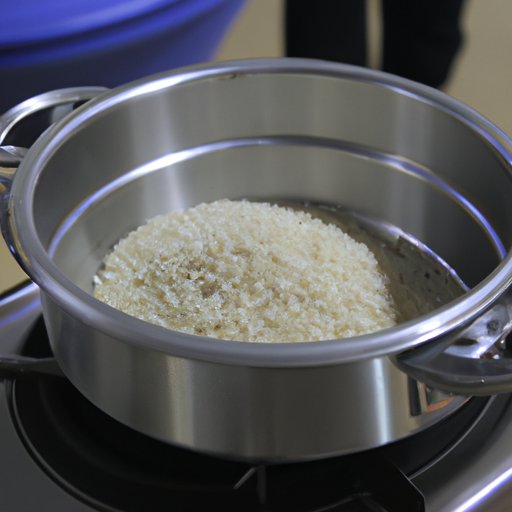I. Introduction
Cooking rice on the stove can be a simple task for some, but others may find it a little tricky. Perfecting the ratio of water to rice and avoiding common mistakes like under-cooked or sticky rice can be a challenge. However, with a few helpful tips and techniques, anyone can cook fluffy and flavorful rice on the stove. This article aims to provide a comprehensive guide on how to cook rice on the stove, including tips for preventing common mistakes, the perfect ratio of water to rice, spice ideas, international style, easy alternatives and proper storage and reheating techniques.
II. The Classic Method
The classic method of cooking rice on the stove is a straightforward process that requires just three ingredients: rice, water, and salt. Begin by rinsing the rice thoroughly to remove excess starch. Then, put the rice in a pot with the correct amount of water and a pinch of salt. Bring the pot to a boil, then reduce the heat to low and cover the pot with a tight-fitting lid. Allow the rice to simmer for 18-20 minutes without removing the lid. After this time, remove the pot from the heat and let it stand for 5-10 minutes before fluffing with a fork.
Some common problems that arise during this method include, overcooking, undercooking, and sticking to the pot. To prevent these issues, be sure to keep an eye on the pot while the rice is cooking and avoid stirring the rice. Also, make sure the pot lid fits tightly to build up steam pressure and avoid removing the lid during the cooking process. This helps ensure even cooking and fluffy rice.
III. The Perfect Ratio
Getting the perfect ratio of water to rice is crucial to achieving perfectly cooked rice. The general guideline is to use one and a half cups of water for every one cup of rice; however, this ratio can vary depending on altitude and type of rice used. If you are cooking one cup of rice, use one and a half cups of water. If you are cooking two cups of rice, use three cups of water. For altitude above 3,000 feet, add an extra quarter cup of water for each cup of rice. Different types of rice may require different ratios of water, so be sure to check the package instructions. If you find that your rice is still too dry or too soggy after cooking, adjust the ratio of water and rice accordingly.
IV. Spice it Up
If you’re looking to add some flavor and variety to your rice dishes, consider experimenting with herbs, spices, and other ingredients. Some spices and herbs you might want to consider include cumin, curry powder, chili powder, thyme, oregano, basil, or turmeric. You can also add a squeeze of lime or lemon once the rice is cooked, or sprinkle some chopped parsley or cilantro on top for a fresh herb flavor. If you’re feeling adventurous, try adding some peas, carrots, onions, or bell peppers while cooking the rice for a more substantial meal.
There are many international cuisines that use rice in their traditional dishes. For example, you can try making Spanish paella, Indian biryani, or Japanese sushi. Experiment with different flavors and cuisines to discover your unique rice dish.
V. Mix it Up
Rice is a versatile ingredient that can be used in many different types of dishes. You can enjoy it as a side dish or incorporate it into entrées, soups, salads, and casseroles. Some international dishes that use rice include sushi, fried rice, or stuffed vegetables. Sushi is a popular Japanese dish that uses vinegar rice and can be filled with a variety of ingredients like raw fish, vegetables, and fruits. Fried rice is another popular Chinese dish that includes rice stir-fried with vegetables, eggs, and meat. If you are looking for a healthy option, try stuffed vegetables like peppers or tomatoes filled with a mix of rice, ground beef, and vegetables.
VI. Easy Alternatives
If you are looking to make cooking rice even easier, consider investing in a rice cooker. Rice cookers are countertop appliances that automatically cook rice fast and easy. Another alternative method of cooking rice is baking. Mix rice and appropriate water in a baking dish and bake at 375°F (190°C) for 35-40 minutes. This process is perfect if you have a larger quantity of rice to cook at once. However, this method doesn’t produce the same flavor and texture of rice. Each method has its pros and cons, so experiment to find the best method for you.
VII. Proper Storage and Reheating
When storing cooked rice, keep it in an airtight container in the fridge for up to four days. Rice can be reheated in the microwave or the stove with a little bit of water to keep it moist. Always make sure you reheat the rice thoroughly and avoid leaving it out at room temperature for more than an hour. Leaving rice out can lead to the growth of harmful bacteria that can cause food poisoning.
VIII. Conclusion
Cooking rice on the stove is a skill that everyone can master with the right tips and techniques. Whether you stick with the classic method or try out alternative methods like a rice cooker or baking in the oven, perfectly cooked rice is achievable with a little bit of patience and practice. Experiment with flavors and cuisines and enjoy the versatility and simplicity of one of the world’s most popular food staples.
